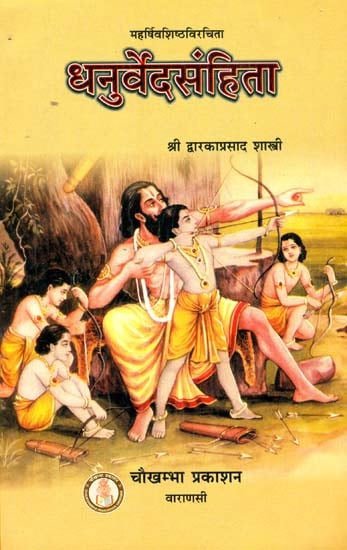Dhanurveda Samhita [sanskrit]
3,015 words
The Sanskrit text of the Dhanurveda-samhita attributed to Vasishtha. Dhanur Veda is a type of ancient India science whose roots date to the 2nd millenium BCE. It is counted among the Upavedas literature. This specific version of the Dhanurveda contains roughly 240 sections of Sanskrit text.
Verse 1.56
गुणाः कार्य्या समुञ्जानां भङ्गस्नाय्वर्कवर्म्मिणाम् ।
अथ शरलक्षणानि ।
अतः परं प्रवक्ष्यामि शराणां लक्षणं शुभम् ।
स्थूलं नाति सूक्ष्मञ्च नोऽपक्वं न कुभूमिजम् ॥ ५६ ॥
guṇāḥ kāryyā samuñjānāṃ bhaṅgasnāyvarkavarmmiṇām |
atha śaralakṣaṇāni |
ataḥ paraṃ pravakṣyāmi śarāṇāṃ lakṣaṇaṃ śubham |
sthūlaṃ nāti sūkṣmañca no'pakvaṃ na kubhūmijam || 56 ||
Note! The following is not a translation of the above verse, but merely an arbitrary extract of the English text.
The qualities of the roots of the trees should be used for breaking muscles and sun worms. Here are the characteristics of the arrows. Next I shall describe the auspicious characteristics of arrows. It is not gross or very subtle, nor is it immature or born of a bad soil.
English translation by Hardayalu Swami (2001) Buy now!
Glossary of Sanskrit terms
Note: This extracts Sanskrit terms and links to English definitions from the glossary, based on an experimental segmentation of verse (1.56). Some terms could be superfluous while some might not be mentioned. Click on the word to show English definitions.
Guna, Samunja, Atha, Sharala, Kshana, Atah, Param, Para, Prava, Kshi, Amin, Shara, Lakshana, Shubha, Shubh, Sthula, Nati, Sukshmam, Asmad, Apakva,
Analysis of Sanskrit grammar
Note: this is an experimental feature and only shows the first possible analysis of the Sanskrit text (Verse 1.56). If the system was successful in segmenting the sentence, you will see of which words it is made up of, generally consisting of Nouns, Pronouns, Verbs, Participles and Indeclinables. Click on the link to show all possible derivations of the word.
- Line 1: “guṇāḥ kāryyā samuñjānāṃ bhaṅgasnāyvarkavarmmiṇām ”
- guṇāḥ -
-
guṇa (noun, masculine)[nominative plural], [vocative plural]guṇā (noun, feminine)[nominative plural], [vocative plural], [accusative plural]
- kāryyā -
-
- samuñjānām -
-
samuñja (noun, masculine)[genitive plural]samuñja (noun, neuter)[genitive plural]samuñjā (noun, feminine)[genitive plural]
- Cannot analyse bhaṅgasnāyvarkavarmmiṇām
- Line 2: “atha śaralakṣaṇāni ”
- atha -
-
atha (indeclinable)[indeclinable]
- śarala -
-
śarala (noun, masculine)[compound], [vocative single]śarala (noun, neuter)[compound], [vocative single]
- kṣaṇāni -
-
kṣaṇa (noun, neuter)[nominative plural], [vocative plural], [accusative plural]
- Line 3: “ataḥ paraṃ pravakṣyāmi śarāṇāṃ lakṣaṇaṃ śubham ”
- ataḥ -
-
ataḥ (indeclinable)[indeclinable]
- param -
-
param (indeclinable)[indeclinable]para (noun, masculine)[adverb], [accusative single]para (noun, neuter)[nominative single], [accusative single]
- prava -
-
prava (noun, masculine)[compound], [vocative single]prava (noun, neuter)[compound], [vocative single]
- kṣyā -
-
kṣi (noun, feminine)[instrumental single]
- ami -
-
amin (noun, masculine)[compound], [adverb]amin (noun, neuter)[compound], [adverb], [nominative single], [vocative single], [accusative single]
- śarāṇām -
-
śara (noun, masculine)[genitive plural]śara (noun, neuter)[genitive plural]
- lakṣaṇam -
-
lakṣaṇa (noun, masculine)[adverb], [accusative single]lakṣaṇa (noun, neuter)[adverb], [nominative single], [accusative single]lakṣaṇā (noun, feminine)[adverb]
- śubham -
-
śubha (noun, masculine)[adverb], [accusative single]śubha (noun, neuter)[adverb], [nominative single], [accusative single]śubhā (noun, feminine)[adverb]śubh (noun, feminine)[accusative single]
- Line 4: “sthūlaṃ nāti sūkṣmañca no'pakvaṃ na kubhūmijam ”
- sthūlam -
-
sthūla (noun, masculine)[adverb], [accusative single]sthūla (noun, neuter)[adverb], [nominative single], [accusative single]sthūlā (noun, feminine)[adverb]
- nāti -
-
nāti (noun, masculine)[compound], [adverb]nāti (noun, feminine)[compound], [adverb]nāti (noun, neuter)[compound], [adverb], [nominative single], [vocative single], [accusative single]
- sūkṣmañ -
-
sūkṣmam (indeclinable)[indeclinable]
- ca -
-
ca (indeclinable conjunction)[indeclinable conjunction]ca (noun, masculine)[compound], [vocative single]ca (noun, neuter)[compound], [vocative single]
- no' -
-
na (noun, masculine)[nominative single]nu (noun, masculine)[vocative single]asmad (pronoun, none)[accusative plural], [dative plural], [genitive plural]
- apakvam -
-
apakva (noun, masculine)[adverb], [accusative single]apakva (noun, neuter)[adverb], [nominative single], [accusative single]apakvā (noun, feminine)[adverb]
- na -
-
na (indeclinable particle)[indeclinable particle]na (noun, masculine)[compound], [vocative single]na (noun, neuter)[compound], [vocative single]
- kubhūmi -
-
kubhūmi (noun, feminine)[compound], [adverb]
- jam -
-
ja (noun, masculine)[adverb], [accusative single]ja (noun, neuter)[adverb], [nominative single], [accusative single]jā (noun, feminine)[adverb]
Other editions:
Also see the following editions of the Sanskrit text or (alternative) English translations of the Verse 1.56
Dhanurveda Samhita (धनुर्वेदसंहिता)
by Hardayalu Swami (2001)
Publisher: Khemraj Shrikrishnadass
Buy now!
Vasistha’s Dhanurveda Samhita
by Purnima Ray (2023)
Publisher: Khemraj Shrikrishnadas; ISBN-10: 818670289X; ISBN-13: 9788186702895; 88 pages including 18 illustrations;
Buy now!
Dhanurveda Samhita (धनुर्वेदसंहिता) (संस्कृत एवं हिंदी अनुवाद)
by Shri Dwarka Prasad Shastri (2007)
Title: Dhanurveda Sanhita (Hindi translation); Publisher: Chaukhambha Prakashan, Varanasi; 84 pages including 11 illustrations; Author: महर्षि वशिष्ठ (Maharshi Vashistha); Foreword by Dr. Chakradhar Bijalwan.
Buy now!![Dhanurveda Samhita [sanskrit] - book cover](/uploads/a/Dhanurveda-Sanskrit.jpg)

